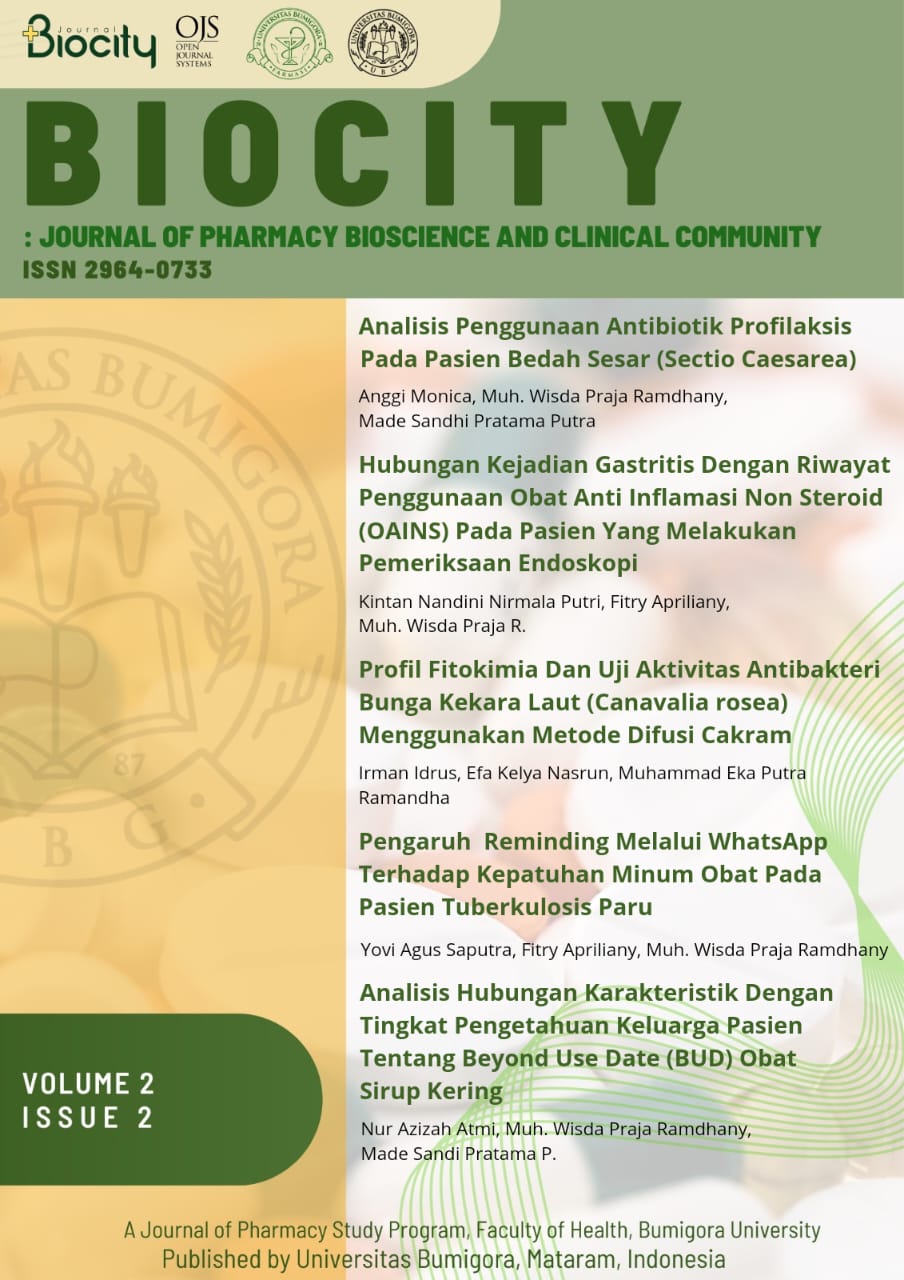The Relationship between Gastritis Incidence and History of Non-Steroidal Anti-Inflammatory Drug (NSAID) Use in Patients Undergoing Endoscopy
Abstract
Gastritis is inflammation of the gastric mucosa, one of which is caused by the use of non-steroidal anti-inflammatory drugs (NSAIDs). It is very common that NSAIDs are used to treat pain, fever, and inflammatory processes. This study aims to examine the relationship between the incidence of gastritis and a history of NSAIDs use. The research method use in this study is a retrospective cohort design of which the data is collected through interview of patients and their families. The patients medical records at the Mataram City Regional Hospital was also collected. Testing was carried out using the Pearson Correlation test. The result shows that gastritis patients were dominated by people aged 36-55 years (46.43%) and 49 of them were female (58.33%). The Pearson Correlation test shows no significant relationship between the incidence of gastritis and a history of NSAID use, with a p-value> 0.05 and an r-value < 1. This indicates a weak relationship between gastritis and the use of NSAIDs. Therefore, the history of NSAIDs use is insignificant as the main reason for gastritis. Gastritis can also be caused by other factors such as age, lifestyle, and stress levels.
References
Choiro. Miftachul., K. (2014). The Relationship Between Stres Level and Gastritis Symptoms Case of grade IV Students in Thesis Progress of Hang Tuah Health Academy Surabaya. Jurnal STIKES Hang Tuah Surabaya.
Davis, R. A. A. D. D. (2014). The special case of diclofenac. Enliven Arch.
Dipiro, J. . (2019). Pharmacotherapy Handbook. The Mc. Graw Hill Company.
Dwiprahasto, I. (2002). Epidemiologi dan Masalah Penggunaan Analgesik Antiinflamasi Non Steroid. In Penggunaan Analgesik dan Antiinflamasi Secara Rasional.
Hakim, L. N. (2020). Urgensi Revisi Undang-Undang tentang Kesejahteraan Lanjut Usia. Aspirasi: Jurnal Masalah-Masalah Sosial, 11(1), 43–55. https://doi.org/10.46807/aspirasi.v11i1.1589
Istiqomah, Putri, D. E. E., Kurniawan, N., & Santoso, N. E. (2022). Profil Penggunaan Analgetik Pada Penderita Sakit Gigi Di Klinik Dido Dental Care Banyuwangi. Jurnal Farmasi Dan Manajemen Kefarmasian, 1(2), 60–65.
Juwariyah, T., & Priyanto, A. (2018). Hubungan Tingkat Pengetahuan dengan Perilaku Pencegahan Kekambuhan Luka Diabetik. Jurnal Ners Dan Kebidanan (Journal of Ners and Midwifery), 5(3), 233–240. https://doi.org/10.26699/jnk.v5i3.art.p233-240
Katzung, B. G. (2011). Farmakologi Dasar dan Klinik Edisi VIII. Bagian Farmakologi Fakultas Kedokteran Universitas Airlangga.
Kresnadi R, D., & Mulyo, K. (2016). Perbandingan Pengaruh Pemberian Analgetik Cox-2Dengan Asam Mefenamat Terhadap Rasa Nyeri PascaOdontektomi (Impaksi Kelas 1, Molar 3 Rahang Bawah). Jurnal Kedokteran Diponegoro, 5(1), 58–64.
Lestari, P. &. (2008). Endoskopi Gastrointestinal. Salemba Medika.
Miftahussurur, M. (2021). Buku Ajar Aspek Klinis Gastritis. Airlangga University Press.
Rahayu, P. (2016). Buku Ajar Keperawatan Maternitas. Salemba Medika.
Sinaga, D. (2013). Pengaruh Stres Psikologis Terhadap Pasien Psoriasis. Jurnal Ilmiah Widya, 1(2).
Singgih, M. F., Achmad, H., Sukmana, B. I., Carmelita, A. B., Putra, A. P., Ramadhany, S., & Putri, A. P. (2020). A Review of Nonsteroidal Anti-Inflammatory Drugs (NSAIDs) Medications in Dentistry: Uses and Side Effects. Systematic Reviews in Pharmacy, 11(5), 293–298.
Sinha, M., Gautam, L., Shukla, P. K., Kaur, P., Sharma, S., & Singh, T. P. (2013). Current Perspectives in NSAID-Induced Gastropathy. 2013.
Soleha, M., Ani, I., Nyoman, F., Rosa, A., & Hamim, T.S., & W. (2018). Profil Penggunaan Obat Antiinflamasi Non Steroid di Indonesia. Jurnal Kefarmasian Indonesia, 8(2), 109–117. https://10.0.87.163/jki.v8i2.316%0A
Srikandi Ardiansyah, E. E. P., Herda Ariyani, & Hendera. (2021). Studi Literatur Efek Penggunaan Non-Steroidal Anti Inflammatory Drugs (Nsaid) Pada Sistem Gastrointestinal (Literature Study Of The Non-Steroidal Anti Inflammatory Drugs (NSAIDs) On The Gastrointestinal System). Journal of Current Pharmaceutical Sciences, 5(2598–2095), 418–428. https://journal.umbjm.ac.id/index.php/jcps/article/view/791
Sukarmin. (2013). Keperawatan Pada Sistem Pencernaan. Pustaka Pelajar.
Suwindiri, Yulius Tiranda, W. A. C. N. (2021). Faktor Penyebab Kejadian Gastritis Di Indonesia : Literature Review. Jurnal Keperawatan Merdeka (JKM), 1(November), 209–223.
Tussakinah, W., Masrul, M., Burhan, I. R. (2018). Hubungan Pola Makan dan Tingkat Stres terhadap Kekambuhan Gastritis di Wilayah Kerja Puskesmas Tarok Kota Payakumbuh Tahun 2017. Jurnal Kesehatan Andalas, 7(2), 217–225. http://dx.doi.org/10.25077/jka.v7i2.805
Usmadi, U. (2020). Pengujian Persyaratan Analisis (Uji Homogenitas Dan Uji Normalitas). Inovasi Pendidikan, 7(1), 50–62. https://doi.org/10.31869/ip.v7i1.2281
Valentine, P. F., & Tina, R. (2013). Pengaruh Polimorfisme CYP2C9*2 dan CYP2C9*3 terhadap Resiko Pendarahan Saluran Gastrointestinal Terapi NSAID. Farmaka Suplemen, 14(1), 1–15.
WHO. (2016). World Health Statistics.
Yanti. (2010). Buku Ajar Kebidanan. Pustaka Rihama.

This work is licensed under a Creative Commons Attribution-ShareAlike 4.0 International License.














